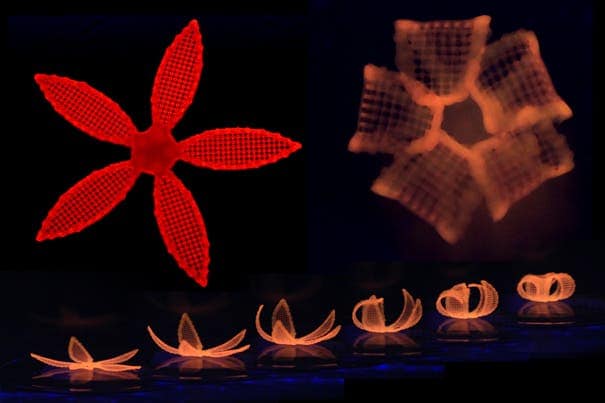A team of Harvard researchers have literally added a new dimension to 3D printing – time. They’ve created nature-inspired objects that change their structure in time.

Credit: Wyss Institute at Harvard University
Biological bodies like plants react and change their form in response to environmental stimuli. While 3D printing has brought us nature-like structures, making said structures adapt like their natural counterparts remains a challenge. Now, scientists from the Wyss Institute for Biologically Inspired Engineering at Harvard University have developed 4D-printed hydrogel composite structures that like plants, change shape when immersed in water.
“This work represents an elegant advance in programmable materials assembly, made possible by a multidisciplinary approach,” said Jennifer Lewis, senior author on the new study. “We have now gone beyond integrating form and function to create transformable architectures.”
The hydrogels they created are programmed to contain precise, localized swelling, so they don’t have the versatility and flexibility that enable changes in plants, but it’s still a promising start.
They aligned tiny cellulose fibers, encoding the hydrogel ink with swelling and stiffness which can be patterned to produce intricate shape changes. The anisotropic nature of the cellulose fibrils gives rise to varied directional properties that can be predicted and controlled. Think of it as wood, which splits more easily along the grain than across it. This simple technique offers surprisingly many folding options:
“Using one composite ink printed in a single step, we can achieve shape-changing hydrogel geometries containing more complexity than any other technique, and we can do so simply by modifying the print path,” said Gladman. “What’s more, we can interchange different materials to tune for properties such as conductivity or biocompatibility.”
The biggest challenge with this technology was developing the right mathematical model for it.
“Our mathematical model prescribes the printing pathways required to achieve the desired shape-transforming response,” said Matsumoto. “We can control the curvature both discretely and continuously using our entirely tunable and programmable method.”
The model’s challenge is to solve the inverse problem. An inverse problem in science is the process of calculating from a set of observations the causal factors that produced them. In this case, the challenge was predicting
what the printing toolpath must be to encode swelling behaviors toward a desired shape.
“It is wonderful to be able to design and realize, in an engineered structure, some of nature’s solutions,” said Mahadevan, who has studied phenomena such as how botanical tendrils coil, how flowers bloom, and how pine cones open and close. “By solving the inverse problem, we are now able to reverse-engineer the problem and determine how to vary local inhomogeneity, i.e., the spacing between the printed ink filaments, and the anisotropy, i.e., the direction of these filaments, to control the spatiotemporal response of these shape-shifting sheets.”
The technology could have applications in printing self-assembling, dynamic microscale structures, especially in medical situations. For example, a structure that changes its shape once it enters the human body, in order to better release its target drug.


